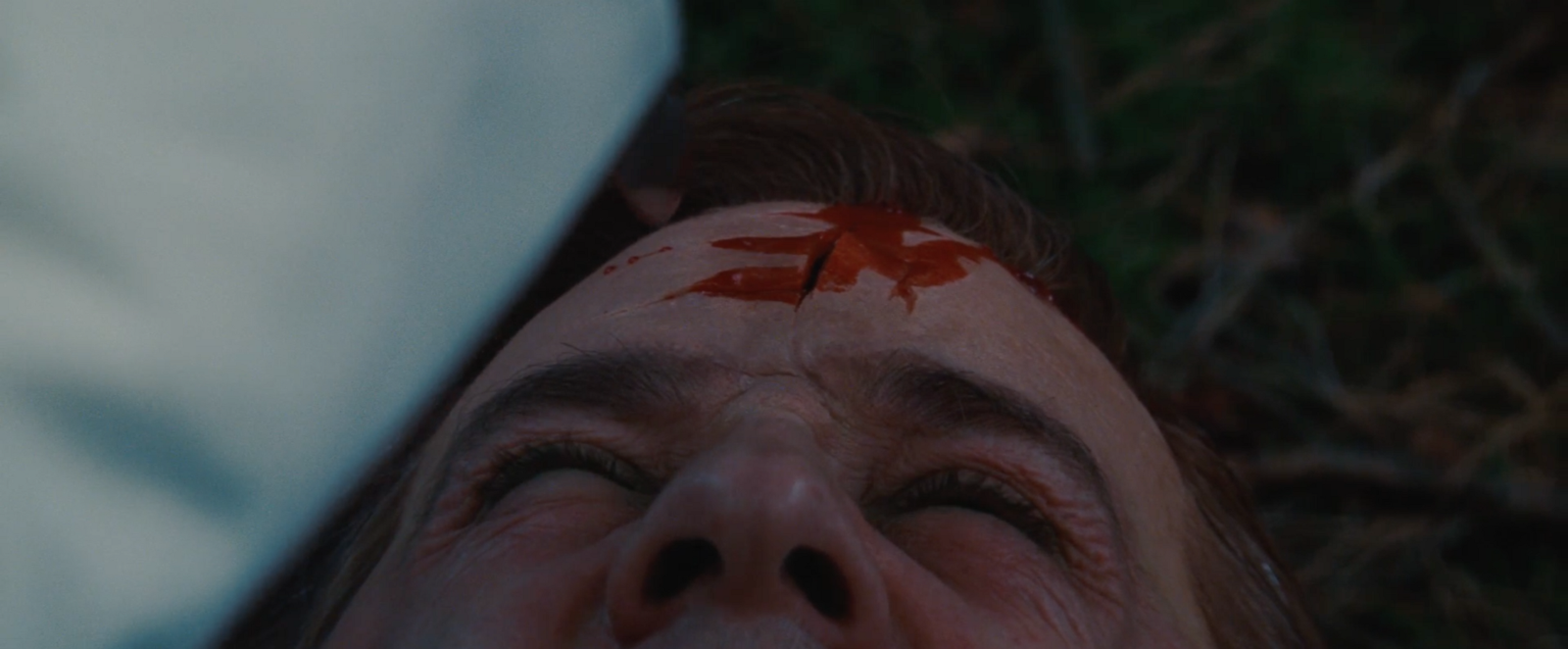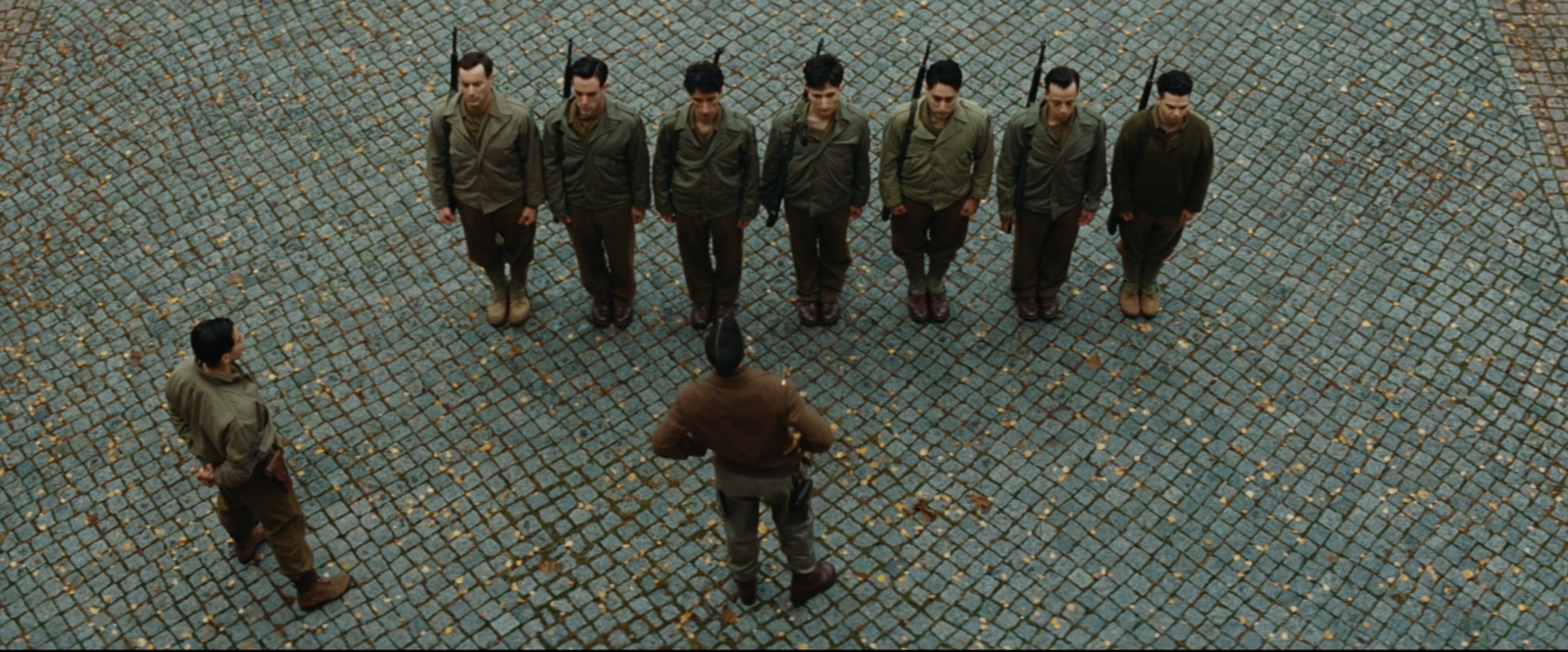 Lt. Aldo Raine
Lt. Aldo Raine
Growing up, Quentin Tarantino and Brad Pitt were born during the midst of the civil rights movement in the 1960?s. To be exact, Tarantino was born March of 1963 in Knoxville Tennessee while Pitt was born in December of the same year in Shawnee, Oklahoma, just months apart from one another [1][2]. By growing up in an era when turning on the television meant seeing African Americans being publicly assaulted by police for their stand against racial inequality, it certainly mended and molded their beliefs and values towards other skin colors. Just look at Brad Pitt and Angelina Jolie, who have adopted three children that each bear different ethnicities of their own [2]. Likewise, Quentin Tarantino explicitly and implicitly shares similar humanitarian views through his public stand against police brutality [3] and his progressive films such as Pulp Fiction and The Hateful Eight.
 Brad Pitt and Quentin Tarantino at the Cannes Film Festival
Brad Pitt and Quentin Tarantino at the Cannes Film Festival
Prior to Inglourious Basterds, Brad Pitt only had one role in Quentin Tarantino?s films ? a very minor one at that. Brad Pitt played Floyd in True Romance, Dick Ritchie?s pot-smoking roommate. Before Brad Pitt played Floyd, he was battling depression in the early 90?s, which he claims was fueled by his pot-smoking. Ironically enough, Brad Pitt had asked director Tony Scott to cast him as the pothead in True Romance, which was perfect given his prior history. [4][5] In the film Inglourious Basterds, however, Brad Pitt puts down the joint and plays the ?the hillbilly from the smoky mountains,? Lt. Aldo Raine, the leader of the Basterds. Shrewdly, Quentin Tarantino?s ploy to cast Brad Pitt was ingenious; Brad Pitt?s views on race and humanity furthers the complexity of Lt. Aldo Raine as a character on and off the screen. By having Pitt play a character whom he shares the same values with, it makes Brad Pitt a genuine actor while making Lt. Aldo Raine an even more genuine character. By casting Brad Pitt, who is the same age as Tarantino, it?s as if Tarantino is projecting his imaginary alter ego onto the big screen ? a redneck from Tennessee joining the war to kick some Nazi-ass.
?The Hillbilly from The Smoky Mountains?
In his first encounter with the Jew Hunter, Colonel Hans Landa (Christoph Waltz), Lt. Aldo Raine attempts to speak Italian by greeting him with the Italian word ?Buongiorno.?
 Lt. Aldo Raine, or Enzo Gorlami in this scene, greets Colonel Hans Landa with the Italian word ?Buongiorno.? The word means ?good morning? yet this scene takes place the evening of the movie premiere?
Lt. Aldo Raine, or Enzo Gorlami in this scene, greets Colonel Hans Landa with the Italian word ?Buongiorno.? The word means ?good morning? yet this scene takes place the evening of the movie premiere?
Although Lt. Aldo Raine was just trying to play the role of Bridget Van Hammersmarck?s (Diane Kruger) Italian escort, his hilarious attempt at trying to speak Italian in his thick southern accent would have made Vincenzo Coccotti from True Romance want to shoot himself. Nevertheless, Lt. Aldo Raine?s distinct southern accent provides cues to his history before his tenure in World War II. According to the screenplay, Tarantino provides small details regarding Raine?s background; ?a hillbilly from the mountains of Tennessee.?
 Notice the scar that wraps around Lt. Aldo Raine?s neck
Notice the scar that wraps around Lt. Aldo Raine?s neck
Tarantino introduces Brad Pitt?s character in the second chapter of the film, titled Inglourious Basterds. In the very first shot of Lt. Aldo Raine, he is seen in a medium close up shot, sporting a brown army trench coat, a beret-like hat, and bears a very distinct scar around his neck. Given the time period in the context of the film, which could have been anywhere from 1939?1945 (the duration of WWII), Aldo Raine must?ve been born somewhere in the early twentieth century, based on his physical appearance. This leads me to believe that Lt. Aldo Raine is somewhere between thirty to forty year-old in the film. Being born in Tennessee during the early twentieth century, Aldo Raine must?ve seen the racial terrorism ensued upon the African Americans.
Despite the connotations of being born white in the heart of the South, Lt. Aldo Raine doesn?t embody the stereotypes of a racist white southerner. In an interview with Ella Taylor, Quentin Tarantino briefly discusses the background behind Brad Pitt?s character. Tarantino tells Taylor that ?Aldo has been fighting racism in the South; he was fighting the Klan before he even ever got into World War II.? [6] As a white southerner fighting against the tyranny of the African Americans, the Ku Klux Klan, Lt. Aldo Raine emits a sense of righteousness and justice for mankind. The addition of this detail adds a layer of complexity to Lt. Aldo Raine as it concerns his character with progressive issues such as civil rights and gives a purpose for his presence in World War II. By providing details regarding his fight against the Ku Klux Klan, Quentin Tarantino purposely developed Aldo Raine as a character from Tennessee and made him the leader of the Jewish Brigade of soldiers for a reason. He wanted to highlight Raine?s values towards humankind despite the stereotypes of a typical white southerner ? making him worthy of leading a pack of soldiers who have a meaningful cause.
Quentin Tarantino edited the screenplay to add on to Lt. Aldo Raine?s part, he adds on:
?We will be cruel to the Germans?It will be thoughts of us that it tortures them with.? ? Lt. Aldo Raine
Quentin Tarantino?s amend to Brad Pitt?s original lines emphasizes Lt. Aldo Raine?s desire to crush the evil and inhumane in the world. Furthermore, his revision of the screenplay draws the connection to pre-World War II Lt. Aldo Raine to the Lt. Aldo Raine in the film as it shows how he views the Nazis through the same lens as the Ku Klux Klan members he fought against ? unjust and immoral ethno-centrists.
The Star (Swastika) of David (Aldo)
?Lt. Aldo Raine has one defining physical characteristic, a rope burn around his neck ? as if, once upon a time, survived a lynching.? Despite how noticeable this scar is, Lt. Aldo Raine?s scar is not mentioned once in the movie. However, Quentin Tarantino?s backstory of Lt. Aldo Raine perfectly aligns with this mysterious scar. Tarantino discussed that Lt. Aldo Raine had been fighting the Klan before he got involved in World War II. Hence, Aldo Raine must?ve presumably obtained his scar by a failed lynching by the Ku Klux Klan for fighting against them. Symbolically, Lt. Aldo Raine?s lynching scar can be seen as a representation of the American cruelty towards the African Americans, spanning from beginning of slavery up until the end of the civil rights movement.
 Medium shot of Lt. Aldo Raine that shows his scar
Medium shot of Lt. Aldo Raine that shows his scar
Here we see Lt. Aldo Raine in a medium close-up shot. It shows his bowtie untied and his wing-tipped collar undone, revealing his scar. Throughout the whole movie, Lt. Aldo Raine hides his scar, through the use of scarfs and wing-tipped collars, up until this point. Lt. Aldo Raine ditches scarfs and collars and reveals his scar to Hans Landa, as some sort of forewarning of what will happen to Landa next.
 Taratino?s infamous corpse point-of-view shot
Taratino?s infamous corpse point-of-view shot
As we transition to the very final scene of the film, Lt. Aldo Raine and Utivich are shown in one of Tarantino?s signature trademark shots, ?the corpse point-of view? shot. [7] The shot creates the illusion that we are viewing Raine and Utivich from Hans Landa?s point of view. Furthermore, the corpse point-of-view shot depicts them as being superior to Hans Landa ? displaying that the good will always trump the evil. As we play closer attention to the shot?s details, we can slightly see Lt. Aldo Raine?s scar through is loosely unbuttoned shirt. The importance of this shot is to show the parallel between the lynching scar on Aldo Raine?s neck and the freshly carved swastika on Landa?s forehead that will soon scar.
 Lt. Aldo Raine carving the swastika into Han?s Landa?s forehead
Lt. Aldo Raine carving the swastika into Han?s Landa?s forehead
Lt. Aldo Raine is well aware that Hans Landa can simply take off his Nazi uniform and no one will ever know about his history as a Nazi. Thus, Raine carves the swastika on his forehead to indicate he was a Nazi, similar to how the Nazis forced the Jews to wear the star of David [8]. Still, the swastika scar serves more than just identification purposes. Lt. Aldo Raine wishes Hans Landa to be reminded of all the Jews he?s captured and killed, such as the family of Shoshanna Dreyfus (Melanie Laurent).
Every time Lt. Aldo Raine sees or even touches his scar, he is reminded of the countless deaths of innocent African Americans, the racial inequalities, and the racially terroristic threats that they faced. The swastika serves to create a similar effect to that of Lt, Aldo Raine?s scar ? to remind him of the Nazi cruelty towards the Jews, which explains a more meaningful purpose for carving the swastika on the Nazis.
The Apache Jews
Lt. Aldo Raine?s swastika carving habits would not have been able to be accomplished alone. In order to make this hillbilly?s dreams of Nazi slaughter come true, Lt. Aldo Raine had to form a brigade of soldiers, and there was no better choice of soldiers than Jewish ones at that. The composition of the renegade of Jewish soldiers is very intriguing. One would assume that the Basterds would be composed of first generation Jews who have witnessed the Nazi tyranny, ranging from Kristallnacht to concentration camps. However, Tarantino assembles the group with a bunch of second generation Jews, such as Donowitz (Eli Roth), Utivich, and Ulmer (Omar Doom).
 An aerial shot of Lt. Aldo Raine facing his new Jewish brigade of soldiers
An aerial shot of Lt. Aldo Raine facing his new Jewish brigade of soldiers
Tarantino?s purpose in creating second generation Jews as the main troopers in the Basterds is to highlight each and everyone of their yearning for justice against these ?crimes against humanity,? like that of their leader, Lt. Aldo Raine [9]. These second generations Jews, who were born in America, never witnessed how what their parents were treated by the Nazis. Sure, first generation Jews who have a burgeoning hatred towards the Nazis would have been fine too. However, these second generations Jews realized how inhumane the Nazis were towards the Jews, for no legitimate reason at all, similar to how Lt. Aldo Raine must?ve came to the belief that what the Ku Klux Klan was doing was wrong. Thus, Lt. Aldo Raine?s figure is crucial to the Basterds since he serves as the archetype for their very cause to save humanity in the film.
In addition to his southern roots, Lt. Aldo Raine is given the nickname ?the Apache? by the Nazis in the film. The nickname alludes to Lt. Aldo Raine?s penchant for scalping every Nazi soldier he kills. Nonetheless, Lt. Aldo Raine?s moniker among Nazi soldiers is important in connection to his Kippah [10] wearing comrades. Quentin Tarantino parallels the Jews and the Apache Indians in order to highlight the similarity between the two groups.
After the conquest of the kingdom of Judah in 598 BCE, the Israelites were forced out of their homeland in what is known as the Babylonian Exile [11]. Similarly, the Apache Indians have had their share of coerced abandonment of their homelands as well. In 1875, the United States military removed the Apaches from their Rio Verde Indian Reserve, a thousand acres of treaty lands promised to the them by the United States government. [12]
In a way, the Jews and the Apaches are indeed similar; they?ve both experienced their fair share of unjust treatment. Similar to how Hans Landa hunts down Jews, Governor Pesquiera, he offered a bounty of $100 per scalp for Apaches in 1863. Despite the bounty on their heads, the Apaches put up a fight; ?they were fierce, hard, relentless fighters.? [13] Due to these brave qualities, Lt. Aldo Raine?s Native American nickname links these two groups of people. Furthermore, the parallel between the Apaches and the Jews also accentuate the common hardships they have faced from other groups such as the Americans and the Nazis. With ?the Apache,? Lt. Aldo Raine, serving as the leader of the Basterds, it?s as if Tarantino is implanting the Native American spirit in the Jews to help them fight back against the Nazis and reclaim their homes in war-torn Europe, so that the Jews don?t relive their history.
At first glance, some may think that making Lt. Aldo Raine the leader of the Basterds is unfitting. How could a white southerner from the Smoky Mountains ever empathize with a group of Jews, let alone lead them into war? Sure, making Donny Donowitz the leader of the Basterds would have worked, but that?s too simple and one-dimensional for Tarantino?s style. A Jew leading a pack of Jews to war against Nazis ? how dull. A southern hillbilly leading a pack of Jews to war ? great dichotomy. Nevertheless, Quentin Tarantino?s conception of choosing Lt. Aldo Raine as the leader of the Basterds over someone such as Donny Donowitz stresses a greater point. If the world can?t abandon the stigma associated with one?s skin color, then humanity will ultimately face its demise. One?s race should never dictate how they act or how they?re treated. Had Aldo Raine had conformed to what his skin color and heritage dictated, he would have been the one lynching the African Americans rather than saving them.
References
[1] ?Quentin Tarantino.? Bio.com. A&E Networks Television, n.d. Web. 05 May 2016.
[2] ?Brad Pitt.? Bio.com. A&E Networks Television, n.d. Web. 05 May 2016.
[3] Satlin, Alana H. ?Quentin Tarantino Defends Police Brutality Comments.?Huffpost Entertainment. N.p., 5 Nov. 2015. Web. 5 May 2016.
[4] King, Pierce. ?Brad Pitt: I Was a Real Life True Romance Stoner with Depression.? Movie Trailers Movies. Purple Revolver, 27 Jan. 2012. Web. 29 Apr. 2016.
[5] Cormier, Roger. ?18 So Cool Facts About ?True Romance?? Mental Floss. N.p., n.d. Web. 29 Apr. 2016.
[6] Taylor, Ella. ?Quentin Tarantino: The Inglourious Basterds Interview.? Village Voice. The Village Voice, 18 Aug. 2009. Web. 03 Apr. 2016.
[7] ?The Quentin Tarantino Archives.? Quentin Tarantino?s Trademarks -. Quentin Tarantino Wiki, n.d. Web. 03 Apr. 2016.
[8] ?Star of David?. Encyclopdia Britannica. Encyclopdia Britannica Online.Encyclopdia Britannica Inc., 2016. Web. 04 May. 2016.
[9] Bergen, Doris L. The Holocaust: A Concise History. Lanham, MD: Rowman & Littlefield, 2009. Print.
[10] The Kippah is the dome like cap that Jewish men wear
[11] The Editors of Encyclopdia Britannica. ?Babylonian Exile.? Encyclopedia Britannica Online. Encyclopedia Britannica, n.d. Web. 03 Apr. 2016.
[12] Sturgis, Amy H. The Trail of Tears and Indian Removal. Westport, CT: Greenwood, 2007. Print.[13] Woodward, Arthur. ?Side Lights On Fifty Years of Apache Warfare 1836?1886.? Arizoniana 2.3 (1961): 3?14. Web.
[13] Woodward, Arthur. SIDE LIGHTS ON FIFTY YEARS OF APACHE WARFARE 1836?1886. 3rd ed. Vol. 2. N.p.: Arizona Historical Society, n.d. Print.


